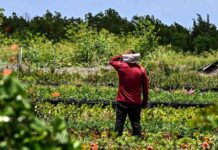Valley Fever Outbreak Connected to California Music Festival: Health Officials Identify Hotspot
Several individuals have recently been diagnosed with Valley fever, also known as coccidioidomycosis, following their attendance at an outdoor music festival near Bakersfield, California. The California Department of Public Health (CDPH) has confirmed that the infection was linked to Lightning in a Bottle, a popular music festival held at Buena Vista Lake from May 22-27.
The fungal infection, caused by inhaling spores found in the soil of California and some parts of the southwestern U.S., has affected at least five festival-goers, with three requiring hospitalization. With over 20,000 attendees at the event, health officials are warning of the potential for additional cases to emerge among those who were present.
Identifying Valley Fever Hotspots
Tom Langdon Hill, director of training for the CCHS Foundation in Tucson, Arizona, noted that the outbreak at Lightning in a Bottle occurred in an area already recognized as a hotspot for Valley fever. In 2022 alone, 34 deaths were attributed to the disease in the region.
Symptoms of Valley fever typically include cough, fatigue, fever, difficulty breathing, and chest pain, manifesting within one to three weeks of exposure. While most individuals exposed to the fungus do not fall ill, about 40% will develop respiratory symptoms, according to the Centers for Disease Control and Prevention (CDC).
Rising Cases and Transmission
California has seen a significant increase in Valley fever cases, with numbers tripling between 2014 and 2018. Each year from 2018 to 2022, the state recorded between 7,000 and 9,000 cases. The infection is most prevalent in the San Joaquin Valley and Central Coast regions, with certain activities like construction, farming, and military training posing higher risks of exposure.
Homeless populations, who often spend extended periods in dusty environments, are particularly vulnerable to Valley fever. According to Dr. Hill, individuals experiencing homelessness have elevated rates of both contracting the disease and suffering severe complications.
Potential Spread and Climate Change
While Valley fever has historically been concentrated in specific regions, researchers are now warning of its potential expansion to new areas due to climate change. Studies have suggested that the disease could spread to northwestern states like Idaho, Wyoming, and Montana in the coming decades.
Dr. George Thompson of UC Davis Health highlighted a recent uptick in cases, noting that more patients are seeking diagnosis and treatment for Valley fever. He acknowledged the possibility of the disease reaching states like Nebraska and Missouri, based on emerging cases reported in these regions.
Treatment and Prevention Strategies
Diagnosing Valley fever typically involves blood tests and imaging scans to detect pneumonia if present. Antifungal medications such as Fluconazole and Itraconazole are commonly used to treat the infection, as there is currently no vaccine available.
Efforts are underway to develop vaccines for Valley fever, with promising results seen in canine trials. The National Institute of Allergy and Infectious Diseases (NIAID) has allocated funding for research on diagnostics, therapeutics, and vaccines to combat the disease.
Vulnerable Groups and Protective Measures
Certain populations, including older individuals, those with weakened immune systems, pregnant women, people with diabetes, and specific ethnic groups, are at higher risk of developing severe forms of Valley fever. Health experts recommend avoiding dusty environments and wearing protective masks, especially for those in high-risk categories.
Early detection and treatment are crucial in managing Valley fever, underscoring the importance of seeking medical attention promptly if symptoms arise. By staying informed about the disease and taking preventive measures, individuals can reduce their risk of exposure and potential complications.
Conclusion
The recent outbreak of Valley fever linked to a California music festival serves as a stark reminder of the ongoing health risks posed by environmental factors. As cases continue to rise and the disease potentially spreads to new regions, proactive measures in diagnosis, treatment, and prevention are essential in addressing this public health concern. By raising awareness and implementing effective strategies, we can work towards mitigating the impact of Valley fever and safeguarding community health.

















